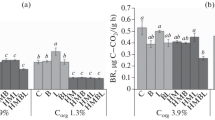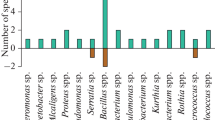Abstract
Microbial decomposition of coumarin was studied in samples of chernozem soil by manometric measurement of oxygen consumption, paper chromatography of aromatic metabolic intermediates in soil extract and measurement of their UV spectra, and by the technique of simultaneous adaptation. Coumarin is decomposed in soil viao-coumaric and melilotic acids and at least one other compound of aromatic character. The metabolic pathway including salicylic acid and catechol was not proved. A total of 39 strains of coumarin-decomposing bacteria were isolated from the soil, out of which 25 belong to the genusPseudomonas, 7 to the genusCellulomonas and 7 to the genusAchromobacter. A comparison of the counts of bacteria utilizing coumarin as a sole carbon source in garden soil, in two chernozem soil samples and in acidic brown soil showed that their occurrence bears no relation to the so-called total number of bacteria (grown on agar medium with yeast and soil extracts and with tryptone) or to the content of carbon and nitrogen in the soil, or to its acidity.
Similar content being viewed by others
References
Audus L. J., Quastel J. H.: Coumarin as a selective phytocidal agent.Nature (London)159, 320 (1947).
Austin D. J., Clarke D. D.: Production of coumarins byPhytophtora infestans.Nature (London)210, 1165 (1966).
Beilsteins Handbuch der organischen Chemie, 4. Aufl. Bd. 10, p. 241 (1927).
Bellis D. M.: Metabolism of coumarin and related compounds in cultures ofPenicillium species.Nature (London)182, 806 (1958).
Bergey's Manual of Determinative Bacteriology. The Williams and Wilkins Co., Baltimore 1957.
Domsch K. H.: Die Messung von Abbaufolgen im Boden. Soil organisms. Proc. of the colloquium on soil fauna, soil microflora and their relationships, p. 22. Oosterbeek, The Netherlands 1962.
Fernley H. N., Evans W. C.: Oxidative metabolism of polycyclic hydrocarbons by soilPseudomonads.Nature (London)182, 373 (1958).
Frost P., Levy C. C.: Metabolism of coumarin by a micro-organism.Nature (London)210, 737 (1966).
Grigg G. W.: Effects of coumarin, pyronin Y, 6,9-dimethyl 2-methylthiopurin and caffeine on excision repair and recombination repair inEscherichia coli.J. Gen. Microbiol.70, 221 (1972).
Hais I. M., Macek K.: Paper chromatography.Publ. House Czech. Acad. Sci. Prague, 1963.
Halvorson H.: Ph. D. Thesis, McGill University, Montreal, Canada 1961. Through Towers, G. H. N.: Metabolism of phenolics in higher plants and micro-organisms, p. 249. In: Harborne J. B. (ed.):Biochemistry of phenolic compounds. Academic Press, London New York 1964.
Harborne J. B., Simmonds N. W.: The natural distribution of the phenolic aglycones, p. 7. In: Harborne J. B. (ed.):Biochemistry of phenolic compounds. Academic Press, London New York 1964.
Kunc F.: Decomposition of vanillin by soil microorganisms.Folia Microbiol.16, 41 (1971).
Kunc F., Macura J.: Oxidation of aromatic compounds in soil.Folia Microbiol.11, 248 (1966).
Levy C. C.: Metabolism of coumarin by a micro-organism:o-coumaric acid as an intermediate between coumarin and melilotic acid.Nature (London)204, 1059 (1964).
Levy C. C., Weinstein G. D.: Metabolism of coumarin by a microorganism.Nature (London)202, 596 (1964a).
Levy C. C., Weinstein G. D.: The metabolism of coumarin by a microorganism. II. The reduction ofo-coumaric acid to melilotic acid.Biochemistry3, 1944 (1964b).
Manual of Microbiological Methods. Society of American Bacteriologists. McGraw-Hill Book Co., New York 1957.
Moreau R., Augier J.: Sur l’utilisation de la vanilline par les microorganismes du sol.C. R. Acad. Sci., Paris,254, 555 (1962).
Moreau R., Jacob M., Augier J.: Sur le métabolisme du phénol dans les sols.C. R. Acad. Sci., Paris,251, 1179. (1960).
Rivière J., Chaussat R.: Destruction de la coumarine dans la rhizosphère.Ann. Inst. Pasteur111, 155 (1966).
Rivière J., Chaussat R.: Libération de la coumarine par les microorganismes du sol.Ann. Inst. Pasteur113, 109 (1967).
Rogoff M. H.: Oxidation of aromatic compounds by bacteria.Adv. Appl. Microbiol.3, 193 (1961).
Shieh H. S., Blackwood A. C.: Use of coumarin by soil fungi.Canad. J. Microbiol.15, 647 (1969).
Smith I.: Chroatographic Techniques. William Heinemann, London 1958.
Stanier R. Y.: Simultaneous adaptation. A new technique for the study of metabolic pathways.J. Bacteriol.54, 339 (1947).
Svensson S. B.: The effect of coumarin on root growth and root histology.Physiol. Plant.24, 446 (1971).
Taylor C. B.: The nutritional requirements of the predominant flora of the soil.Proc. Soc. Appl. Bact.14, 101 (1951).
Author information
Authors and Affiliations
Rights and permissions
About this article
Cite this article
Kunc, F. Microbial decomposition of coumarin in soil. Folia Microbiol 19, 209–217 (1974). https://doi.org/10.1007/BF02895020
Received:
Issue Date:
DOI: https://doi.org/10.1007/BF02895020




